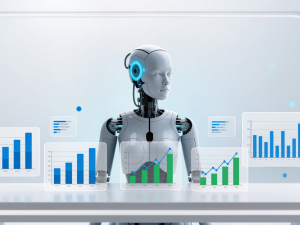For years, IT support followed the same pattern. A user raised a ticket, someone in the helpdesk queue sorted through it, and a technician finally stepped in to troubleshoot. It worked, but it was slow, reactive, and often overloaded. As organizations added more devices, more apps, and more users working across different environments, the old support model started to fall behind. AI has changed that rhythm completely. Instead of waiting for issues to pile up, AI helpdesks step in at the very first moment a user reports a problem. They understand natural language, offer instant solutions, run diagnostics, and even prevent some issues before they ever reach a human agent. Support teams no longer spend hours resetting passwords or untangling repetitive tickets. They finally have room to focus on the complex cases that genuinely need their expertise.
What this creates is a new era of troubleshooting one built on speed, prediction, and smarter workflows. And for IT students preparing for the field, understanding this shift isn’t optional anymore. It’s becoming the foundation of modern IT support.
AI-First Ticketing: How Support Starts Before a Human Steps In?
The biggest change in modern helpdesks is what happens right at the start of a support request. Instead of waiting for a technician to read a ticket, AI systems now handle the first interaction automatically. This is where most of the speed and efficiency gains happen. AI chatbots use Natural Language Processing to understand user messages in plain English. A simple “My Wi-Fi keeps disconnecting” or “I can’t log in” is enough for the system to identify the issue type, match it to known solutions, and trigger the right action all within seconds.
For routine problems, the AI doesn’t just provide instructions; it fixes the issue outright. Password resets, account unlocks, software restarts, permission conflicts, and basic network checks can all be handled on the spot. Users get immediate help, and the helpdesk never sees the ticket. When the problem is a bit more complex, the AI doesn’t wait for things to get worse. It can run diagnostics in the background, pull system logs, test connections, and generate a clear, structured summary for the human technician who eventually steps in. The result is simple: technicians spend less time gathering information and more time solving the actual problem.
This kind of AI-first triage also improves routing. Instead of guessing which team should handle a ticket, the system sends it directly to the right person based on expertise, workload, and issue priority saving hours of back-and-forth. AI doesn’t replace the help desk. It clears the noise so humans can focus on the high-value work. And that shift is already redefining what IT support looks like.
Automated Diagnostics and Proactive Fixes: When the Helpdesk Solves Problems Before They Happen
Once AI takes over the first layer of support, the next big leap is what it does before a user even knows something is wrong. Traditional IT support was reactive. Someone reported an issue, the helpdesk investigated, and only then did the fix begin. AI reverses that model. Modern AI systems constantly analyze system logs, usage patterns, error trends, and device behaviour. If something looks unusual, a service slowing down, storage filling up, a patch failing, or a network link starting to degrade, the AI flags it instantly. In many cases, it doesn’t just flag; it acts.
AI can reboot stalled services, roll back failed configurations, free up storage, restart background processes, or trigger automated scripts that resolve the issue quietly. Users never notice a disruption, and the helpdesk avoids an entire wave of avoidable tickets. For issues that require human involvement, AI does the heavy lifting ahead of time. It runs system checks, gathers logs, traces errors, tests dependencies, and attaches its findings directly to the ticket. By the time the technician sees it, they already have a full snapshot of what happened and why. This proactive model changes the whole rhythm of IT work. Instead of reacting to problems, teams spend more time preventing them. Instead of firefighting every day, they start planning, optimising, and improving systems.
It makes IT support more predictable, more stable, and dramatically more efficient and it all starts with letting AI take the first pass at diagnostics long before an issue reaches a human.
How AI Changes the Skill Set of Modern IT Support Roles?
As AI becomes the first responder for most technical issues, IT roles start shifting in ways that feel both challenging and exciting. The routine work that used to fill a helpdesk technician’s day password resets, software reinstalls, basic connectivity checks is now handled automatically. That doesn’t remove the human role; it elevates it. Support teams begin working on the kinds of problems AI can’t solve alone: multi-layered system failures, complex networking issues, security escalations, behavioral anomalies, and situations that need human judgement or empathy. Instead of clearing queues, IT professionals spend more time improving processes, optimizing systems, and making decisions AI isn’t trained to make.
This also means entry-level IT pathways are evolving. The first job for many learners won’t be “reset accounts all day.” It’s more likely to involve overseeing AI tools, reviewing automated actions, validating AI decisions, and stepping in when something falls outside expected patterns. The work becomes less repetitive and more analytical. New skills naturally rise to the top. Understanding how AI models behave, how ticketing automations run, and how data flows through the system becomes a core part of the job. Critical thinking, pattern recognition, clear communication, and the ability to diagnose complex scenarios become far more valuable than memorizing step-by-step fixes.
AI doesn’t replace IT support, it reshapes it. People move from being task-executors to being system-thinkers. The helpdesk becomes more strategic, more technical, and closer to real engineering work than ever before.
How IT Learners Can Train for AI + Human Support Workflows?
As AI takes over the repetitive parts of troubleshooting, the next generation of IT professionals will need a different kind of training. The goal isn’t to compete with AI; it’s to work alongside it, treating it like a co-pilot that handles the routine while you focus on the work that actually needs human insight. The starting point is understanding how AI-driven helpdesks function behind the scenes. IT learners should know how chatbots are configured, how ticketing automation rules are built, and how diagnostic scripts run in the background. Once you know how the system makes decisions, you can guide it, fine-tune it, and intervene when something falls outside the automation. Data becomes part of the daily workflow too. AI tools generate a steady flow of logs, patterns, and performance insights. Learning how to read that data spotting anomalies, identifying recurring problems, and shaping better workflows helps you keep the support system efficient and predictable.
Complex troubleshooting will matter more than ever. Since AI clears out simple cases, human technicians handle the issues that require logic, creativity, or empathy. Practicing real-world scenarios, case studies, and multi-layered problem paths becomes essential for building confidence. Blended environments are the best practice space. Training platforms that simulate AI-first ticketing help learners practice when to escalate, when to intervene, and how to collaborate with automated tools for rapid resolution. This prepares them for modern support teams, where AI handles the volume and humans handle the impact.
The more students embrace these blended workflows, the more they’ll stand out. The future of IT support isn’t about choosing between AI or humans. It’s about learning how both can work together to deliver faster, smarter, and far more responsive support.
The Skill Shift: What IT Support Roles Look Like Now
AI helpdesks aren’t just changing how tickets are solved, they’re changing what IT jobs actually look like. The old model was simple: users faced a problem, submitted a ticket, and support teams reacted as quickly as they could. Today’s model is very different. AI handles the first wave of issues, predicts problems before users even notice them, and sends only the tough cases to human technicians.
From reactive to proactive work
Instead of firefighting, IT teams now monitor trends, improve workflows, and tune AI tools so they catch more issues early. The work becomes more strategic and less chaotic.
Why entry-level tasks are shrinking
Password resets, software installs, basic connectivity checks AI clears these instantly. This means fewer traditional entry-level roles and more positions that expect deeper skills from day one.
Growth of specialized AI-support roles
New roles are emerging fast: AI system administrators, automation engineers, workflow designers, and hybrid support specialists who oversee AI behaviour and step in when needed.
Human skills that still matter
AI can follow rules, but it can’t replace judgment or empathy. IT pros who excel in communication, critical thinking, creative problem-solving, and calm decision-making remain essential especially when a situation needs reassurance, negotiation, or deeper investigation.
What Students Must Learn: Training for Blended AI + Human Support
For IT learners, the future isn’t about choosing between AI or human skills, it’s about mastering both. Modern support teams expect you to understand how automation works and how to troubleshoot scenarios that AI can’t solve.
AI system management and configuration
Students must learn how to configure chatbots, refine automation rules, manage AI ticketing flows, and keep models aligned with real user behaviour.
Advanced troubleshooting techniques
Since AI handles the simple cases, humans manage the tricky, layered issues. This demands stronger diagnostic thinking, structured problem paths, and the ability to investigate across systems.
Data analysis for insights and prediction
AI generates patterns in ticket types, peak issues, root causes, and user behaviour. Learning to interpret this data helps you make improvements and predict future problems.
Practizing collaborative AI workflows
Support training now includes learning when to rely on the AI co-pilot, when to override it, and how to work with automation without losing control. Blended labs where learners solve issues alongside an AI tool prepare students for real help desk environments.
The Real Impact: Faster Teams, Happier Users, Smarter Operations
When AI becomes part of the helpdesk, the impact is felt everywhere. Issues get resolved faster because AI handles routine cases instantly. Users wait less and receive more accurate responses. Support teams have more breathing room to focus on the work that actually moves the organization forward. Downtime drops because AI predicts problems before they escalate. Documentation becomes cleaner because automation keeps logs consistent. And leadership gets clearer insights into where systems need improvements.
The overall effect is simple: IT environments feel steadier, smarter, and far more responsive. It’s a win for students, support teams, and the organizations they’ll eventually work in.
Looking Ahead: Will AI Replace Helpdesks?
This question comes up often, but the answer is much more balanced than people think. AI is replacing repetitive tasks, not replacing people. The work isn’t disappearing, it’s shifting. AI handles simple workflows that slow down support teams, like password resets or basic diagnostics. Humans handle the tasks that require nuance, judgment, negotiation, and creativity. In fact, as more organizations adopt AI-first support, the need for skilled technicians actually increases, because someone must maintain these systems, tune the AI, handle high-impact issues, and guide users through problems that automation can’t interpret.
So no, AI isn’t replacing helpdesks. It’s redefining them, and the result is a more efficient, more human, and more strategic support model.
Conclusion: IT Support Is Evolving—Are Learners Ready?
AI isn’t a threat to IT careers, it’s the next chapter. Helpdesks are becoming faster, smarter, and more proactive, and the professionals entering the field will shape how smoothly this shift happens. Students who learn to work alongside AI, manage its workflows, and dive into the complex issues it can’t solve will be the ones leading the future of support.
The message is simple: IT support isn’t disappearing. It’s evolving. And the learners who prepare for blended AI + human environments will be the ones who thrive.
FAQs
1. Can AI helpdesks work without internet connectivity?
Yes. Many AI helpdesk tools run locally or cache essential workflows, allowing them to handle basic troubleshooting even when the network is unstable.
2. Do AI helpdesks need constant retraining?
They need periodic updates, not daily ones. IT teams review patterns, add new rules, and refine responses as systems and user needs evolve.
3. Are AI chatbots able to understand technical jargon used by employees?
Modern AI helpdesks can be trained with company-specific terms, tools, and workflows, so they get better at understanding real-world technical language over time.
4. What happens if the AI routes a ticket to the wrong technician?
Human agents can reassign or correct routing instantly, and the AI learns from these adjustments to improve future accuracy.
5. Do organisations need special hardware to start using AI helpdesks?
Not usually. Most AI support tools run on existing infrastructure and integrate with current ticketing systems without major hardware upgrades.






